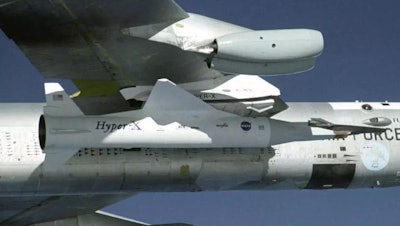
In 2004, NASA’s final X-43A unmanned prototype tests were a milestone in the latest era of jet development — the leap from ramjets to faster, more efficient scramjets. The last test, in November of that year, clocked a world-record speed only a rocket could have achieved previously: Mach 10. The speed equates to 10 times the speed of sound.
NASA culled a lot of useful data from the tests, as did the Air Force six years later in similar tests on the X-51 Waverider, before the prototypes careened into the ocean.
Although hypersonic proof of concept was successful, the technology was far from operational. The challenge was achieving engine control, because the tech was based on decades-old sensor approaches.
This month, however, brought some hope for potential successors to the X-plane series.
As part of a new NASA-funded study, University of Virginia School of Engineering and Applied Science researchers published data in the June issue of the journal Aerospace Science and Technology that showed for the first time that airflow in supersonic combusting jet engines can be controlled by an optical sensor. The finding could lead to more efficient stabilization of hypersonic jet aircraft.
In addition, the researchers achieved adaptive control of a scramjet engine, representing another first for hypersonic propulsion. Adaptive engine control systems respond to changes in dynamics to keep the system’s overall performance optimal.
Stopping ‘Unstart’ To Stay in Control
NASA has long sought to prevent something that can occur in scramjet engines called “unstart.” The term indicates a sudden change in airflow. The name derives from a specialized testing facility called a supersonic wind tunnel, where a “start” means the wind has reached the desired supersonic conditions.
UVA has several supersonic wind tunnels, including the UVA Supersonic Combustion Facility, which can simulate engine conditions for a hypersonic vehicle traveling at five times the speed of sound.
Goyne explained that “scramjets,” short for supersonic combustion ramjets, build on ramjet technology that has been in common use for years.
Ramjets essentially “ram” air into the engine using the forward motion of the aircraft to generate the temperatures and pressures needed to burn fuel. They operate in a range of about Mach 3 to Mach 6. As the inlet at the front of the craft narrows, the internal air velocity slows down to subsonic speeds in a ramjet combustion engine. The plane itself, however, does not.
Scramjets are a little different, though. While they are also “air-breathing” and have the same basic setup, they need to maintain that super-fast airflow through the engine to reach hypersonic speeds.
Testing a Dual-Mode Scramjet Engine
Currently, like ramjets, scramjet engines need a step-up to get them to a speed where they can intake enough oxygen to operate. That may include a ride attached to the underside of a carreir aircraft as well as a rocket boost.
The latest innovation is a dual-mode scramjet combustor, which was the type of engine the UVA-led project tested. The dual engine starts in ramjet mode at lower Mach numbers, then shifts into receiving full supersonic airflow in the combustion chamber at speeds exceeding Mach 5.
Preventing unstart as the engine makes that transition is crucial.
Incoming wind interacts with the inlet walls in the form of a series of shock waves known as a “shock train.” Traditionally, the leading edge of those waves, which can be destructive to the aircraft’s integrity, have been controlled by pressure sensors. The machine can adjust, for example, by relocating the position of the shock train.
But where the leading edge of the shock train resides can change quickly if flight disturbances alter mid-air dynamics. The shock train can pressurize the inlet, creating the conditions for unstart.
He and his collaborators wondered if a pending unstart could be predicted by observing properties of the engine’s flame instead.
Sensing the Spectrum of a Flame
The team decided to use an optical emission spectroscopy sensor for the feedback needed to control the shock train leading edge.
No longer limited to information obtained at the engine’s walls, as pressure sensors are, the optical sensor can identify subtle changes both inside the engine and within the flow path. The tool analyzes the amount of light emitted by a source — in this case, the reacting gases within the scramjet combustor — as well as other factors, such as the flame’s location and spectral content.
The team’s wind tunnel demonstration showed that the engine control can be both predictive and adaptive, smoothly transitioning between scramjet and ramjet functioning.
The wind tunnel test, in fact, was the world’s first proof that adaptive control in these types of dual-function engines can be achieved with optical sensors.
Building Toward the Future
While much more work remains to be done, optical sensors may be a component of the future Goyne believes will be realized in his lifetime: plane-like travel to space and back.
Dual-mode scramjets would still require a boost of some sort to get the aircraft to at least Mach 4. But there would be the additional safety of not relying exclusively on rocket technology, which requires highly flammable fuel to be carried alongside large amounts of chemical oxidizer to combust the fuel.
That decreased weight would allow more room for passengers and payload.
Such an all-in-one aircraft, which would glide back to Earth like the space shuttles once did, might even provide the ideal combination of cost-efficiency, safety and reusability.






















